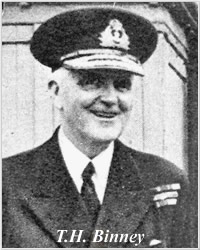Thomas Hugh Binney

Rank: Captain
Joined Hood: 15th August 1932
Left Hood: 30th August 1933
Biographical Information:
Thomas Hugh Binney was born 9th December 1883, at Tolleshunt D'Arcy, Essex. He was known as Hugh (rather than Thomas).
Having joined the Royal Navy as a cadet at H.M.S. Britannia, he served as Gunnery Officer in H.M.S. Queen Elizabeth throughout the First World War and by 1918 was on the staff of the Commander in Chief of the Grand Fleet.
Promoted to rank of Captain in 1922 he served in H.M.S. Cardiff, 1923 to 1925 and was Flag Captain to Admiral Chatfield. Cardiff was a cruiser of 5,400 tons which formed part of the 3rd Cruiser Squadron. (Six "C" class cruisers in all). The squadron operated in the Mediterranean, initially in the Dardinelles area.
He returned to shire as Deputy Director of Plans division at the Admiralty, 1925 to 1927.
In 1928 he returned to sea as Captain of H.M.S. Nelson until1930. Again he was Flag Captain, this time to Chatfield, who at this time was Commander in Chief of the Atlantic Fleet.
His tenure as Captain of H.M.S. Hood lasted from 1932 to 1933 and followed a second period ashore as Director of the Tactical School, 1931 to 1932.
At this stage in his career Binney had already served the usual length of time in a sea-going appointment as a Captain but was appointed to Hood at the behest of Admiral Kelly, Commander in Chief of the Atlantic Fleet, who felt that following the Invergordon mutinies what was needed was a Captain who could "draw the best from his subordinates". His time on Hood included a cruise down the East Coast of the UK (aka "Depression Cruise") which, it was hoped, would both raise the morale of the populace of those parts during the depression, and maintain the prestige of the fleet and Hood herself. The morale of the men did improve and Hood won the Home Fleet regatta. Gunnery also showed marked improvements during Binney's time as Captain (under the guidance and leadership of the Gunnery Officer Longley-Cook). A cruise to Gibraltar and the Mediterranean followed.
On leaving Hood he was appointed Chief of Staff to Commander in Chief, Portsmouth, 1933 to 1935 and ADC to King George V, 1934.
Binney was promoted to Rear-Admiral, 1934 and became Rear-Admiral, 1st Battle Squadron, 1936 to 1938.
Promoted to Vice-Admiral, 1938 he served as Commandant of the Imperial Defence College.
During 1939 he was Chair of Admiralty Committee on use of anti-submarine vessels in which role he recommended that vessels should be used in close support of convoys rather than on independent operations in search of U-boats.
His early war service was as Admiral Commanding Orkneys and Shetlands from 1939 to 1942.
Moved to the retired list in 1943, war time expediency saw his service continue as Flag Officer, Cardiff, 1944.
After the war Binney was appointed Governor of Tasmania, 1945 to 1951
He died on 8th January, 1953.
Additional Photographs
None at this time.
No known memorials
Sources
Commonwealth War Graves Commission
'Register of Deaths of Naval Ratings' (data extracted by Director of Naval Personnel (Disclosure Cell), Navy Command HQ, 2009)
